Introduction
As organizations increasingly recognize the transformative power of cloud technology, the journey towards cloud migration becomes a focal point of strategic planning.
Cloud assessment tools play a crucial role in this process, offering comprehensive evaluations that inform decision-making and optimize resource allocation. By meticulously analyzing an organization's existing IT infrastructure and operational processes, these tools provide invaluable insights into:
- Readiness for cloud transition
- Potential risks
- Opportunities for enhancement
With a growing emphasis on data security and compliance, understanding the capabilities and features of these assessment tools is essential for organizations seeking to navigate the complexities of cloud migration effectively.
As the landscape continues to evolve, the importance of employing robust cloud assessment tools cannot be overstated, making it imperative for businesses to embrace this technology as a means of ensuring a successful and secure transition to the cloud.
Defining Cloud Assessment Tools: An Overview
These evaluation applications function as a cloud assessment tool that thoroughly analyzes a company's preparedness for migration to a virtual environment. These instruments meticulously analyze the existing IT infrastructure, applications, and operational processes to determine which elements are suitable for migration, which require modifications, and which should remain on-premises. Through performing a thorough evaluation, companies acquire essential insights into their present surroundings and the numerous advantages linked to moving to the digital infrastructure.
The importance of these resources is highlighted by recent discoveries, with 44% of participants in Flexera’s 2023 State of the Digital Infrastructure indicating that shifting more workloads to the digital environment is a main priority for the upcoming year. Moreover, with Amazon Web Services (AWS) controlling 31% of the infrastructure services market, organizations must strategically evaluate their migration readiness to stay competitive. Characteristics frequently found in online evaluation resources, such as cost analysis, performance metrics, and compliance checks, are essential for well-informed migration decision-making with a cloud assessment tool.
Furthermore, these resources not only simplify the evaluation process but also improve the overall success rates of migrations when utilizing a cloud assessment tool. By utilizing sophisticated algorithms, readiness evaluation resources automate the detection of possible challenges and opportunities, facilitating a smoother transition. A case study titled 'Enhanced Security through Migration to Virtual Services' demonstrates that entities can significantly strengthen their protective measures after migration, due to the stringent protocols established by service providers and the knowledge of elite cybersecurity experts.
As the realm of virtual technology progresses, especially with the rising focus on artificial intelligence integration—an aspect where 56% of IT decision makers indicate uncertainty about their providers' strategies—comprehending the features and capacities of evaluation instruments becomes increasingly essential. This ambiguity emphasizes the necessity for enhanced clarity from service providers, reinforcing the significance of using evaluations to ensure strong security and compliance while effectively utilizing technology.
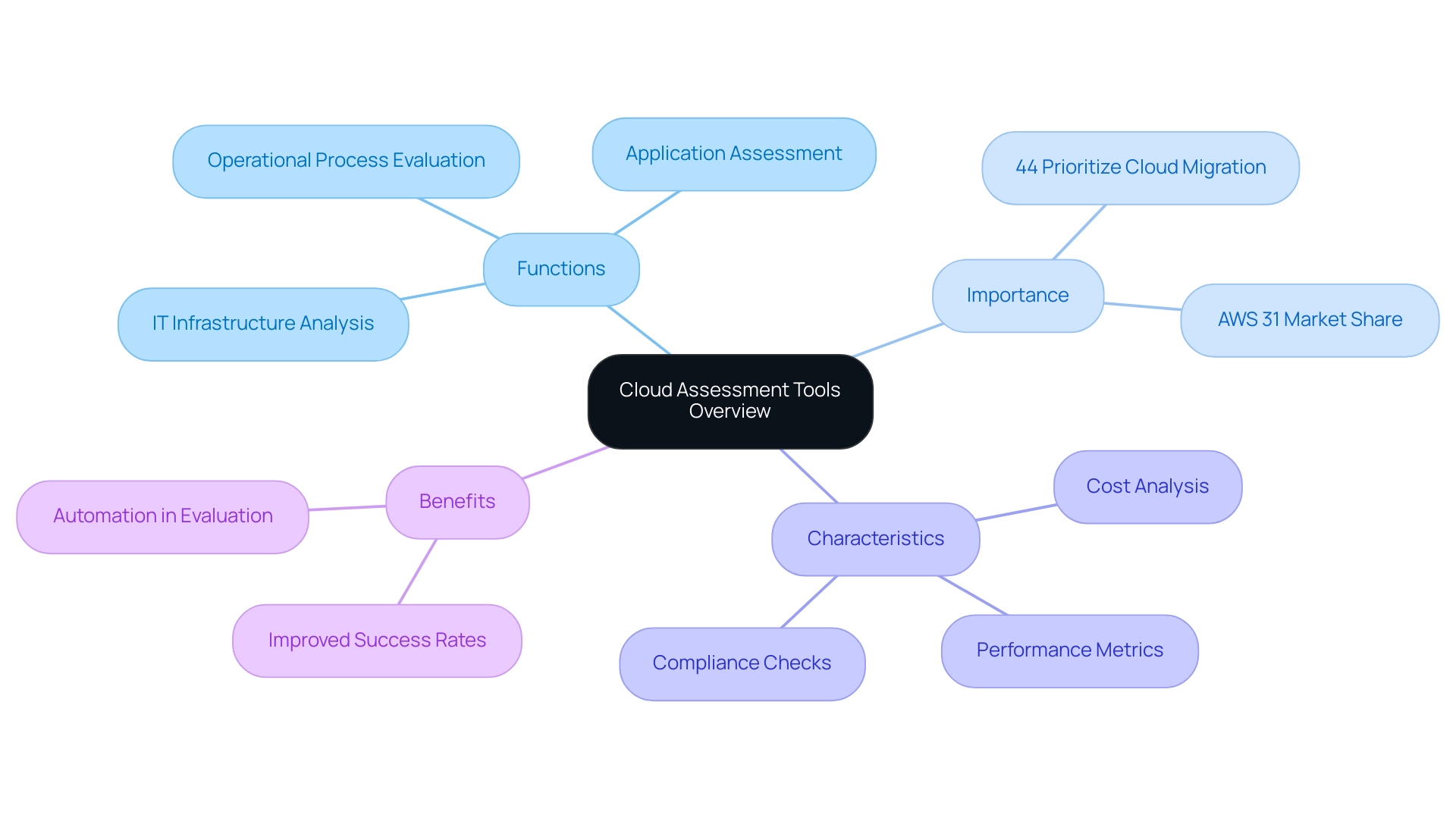
The Role of Cloud Assessment Tools in Streamlining Migration
Cloud evaluation resources, such as a cloud assessment tool, are essential in enhancing the cloud migration procedure, providing a structured framework for assessing a company's IT environment. These tools generate comprehensive insights into application dependencies, performance requirements, and potential migration-related risks. By pinpointing these critical factors, entities can effectively prioritize migration initiatives and allocate resources with precision, thereby mitigating foreseeable challenges.
Significantly, 75% of entities reported a rise in digital waste, with some estimates indicating that waste could reach as high as 47% of digital budgets. This emphasizes a major challenge in overseeing online resources efficiently, as demonstrated by the case study titled 'Rising Waste in the Cloud,' which shows that entities are having difficulty managing their expenses. Consequently, it becomes crucial to employ a cloud assessment tool as an evaluation instrument for effective resource management and cost optimization.
Additionally, these resources aid in precise cost assessments, allowing entities to understand the financial effects of the digital transition. This insight not only supports informed budget planning but also uncovers significant cost-saving opportunities through optimized resource allocation. Furthermore, numerous platforms for evaluating include a cloud assessment tool that facilitates compliance and security reviews, guaranteeing conformity to regulatory requirements during the migration process.
In essence, the strategic use of a cloud assessment tool significantly enhances the likelihood of a successful and efficient migration, which is a necessity for companies aiming to modernize their IT infrastructure. As Cody Slingerland, a FinOps certified practitioner, points out, 'Implementing a structured evaluation framework is essential for any organization aiming to manage the intricacies of migration effectively.' Furthermore, it is significant that half of the surveyed enterprises regard online computing as a contemporary data protection approach, highlighting the necessity of digital evaluation resources in securing information during migration.
Ultimately, the thorough evaluation carried out by Mission on Employ's digital infrastructure shows how evaluation methods can pinpoint optimization opportunities and migration-ready workloads, highlighting their essential role in the migration process.
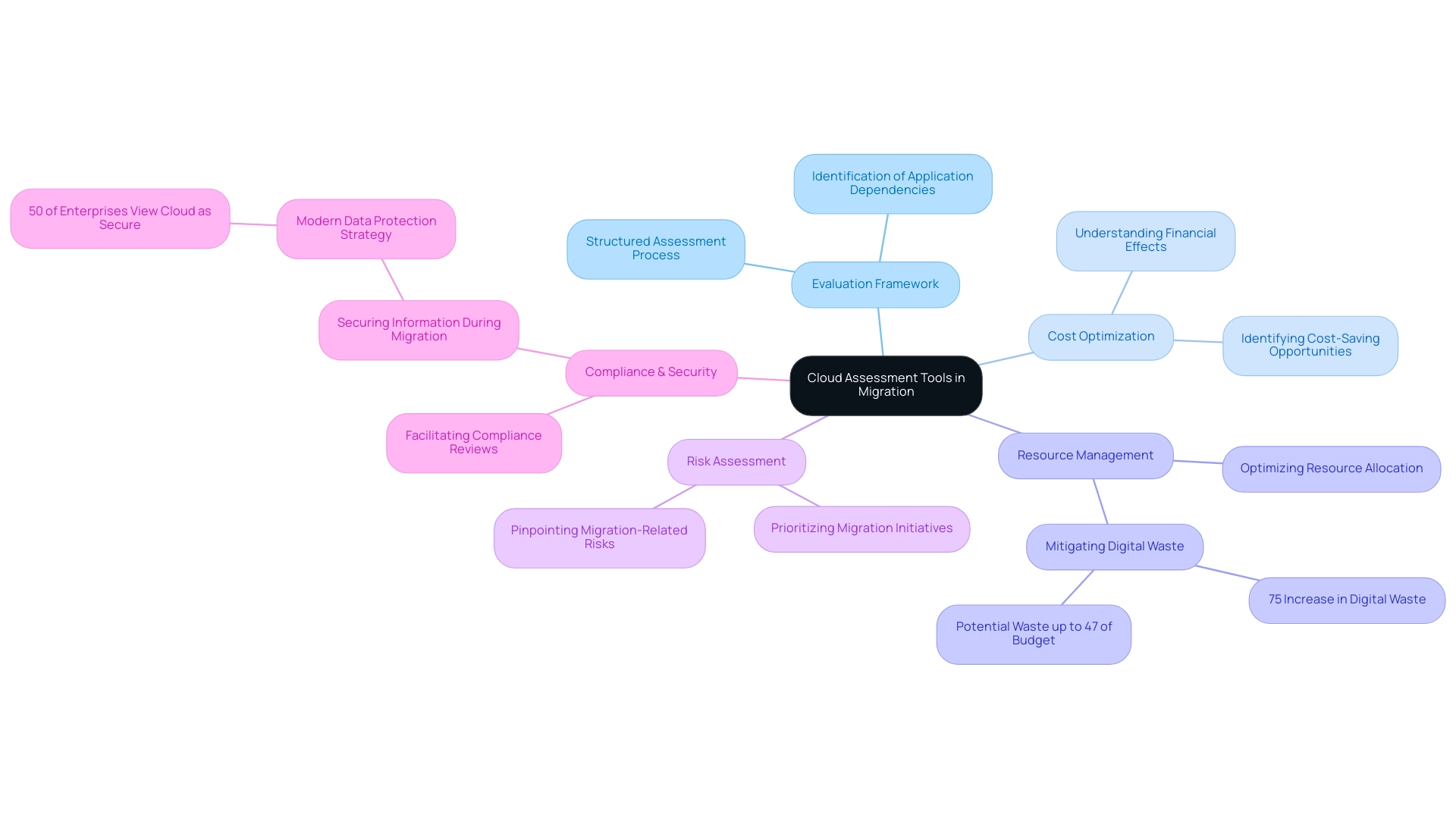
Key Features of Effective Cloud Assessment Tools
Efficient assessments with a cloud assessment tool are crucial for entities managing the intricacies of migration and optimization in a digital infrastructure. Key features of the cloud assessment tool include:
- Automated discovery of assets, enabling organizations to swiftly identify all applications and services operating within their environments, thus providing a holistic view of their IT landscape. This capability is particularly crucial given that, in many online environments, a mere 5% of security rules account for 80% of alerts, highlighting the need for precise rule management.
Moreover, as more workloads are anticipated to shift to online environments due to the advantages surpassing the challenges, robust reporting capabilities empower users to generate insights into:
- Resource utilization
- Performance metrics
- Potential risks
This enables informed, data-driven decision-making. Integration with current IT management systems is another essential feature, ensuring that the cloud assessment tool can seamlessly fit into a company's workflow and enhance collaboration among teams. Other noteworthy functionalities include:
- Cost forecasting, which aids in anticipating expenses related to cloud migration
- Compliance tracking, which ensures adherence to industry regulations throughout the transformation process.
As Broadcom points out, only 20% of organizations currently demonstrate cloud-savvy capabilities, underscoring the significant challenges faced by the majority. This complexity reinforces the necessity for effective instruments. Moreover, the robust expansion of Google Cloud's IaaS service—at 63.7%—not only underscores the need for comprehensive online services but also establishes Google Cloud as a key participant in the market, further highlighting the significance of utilizing a cloud assessment tool as an efficient digital evaluation resource in today’s technological environment.
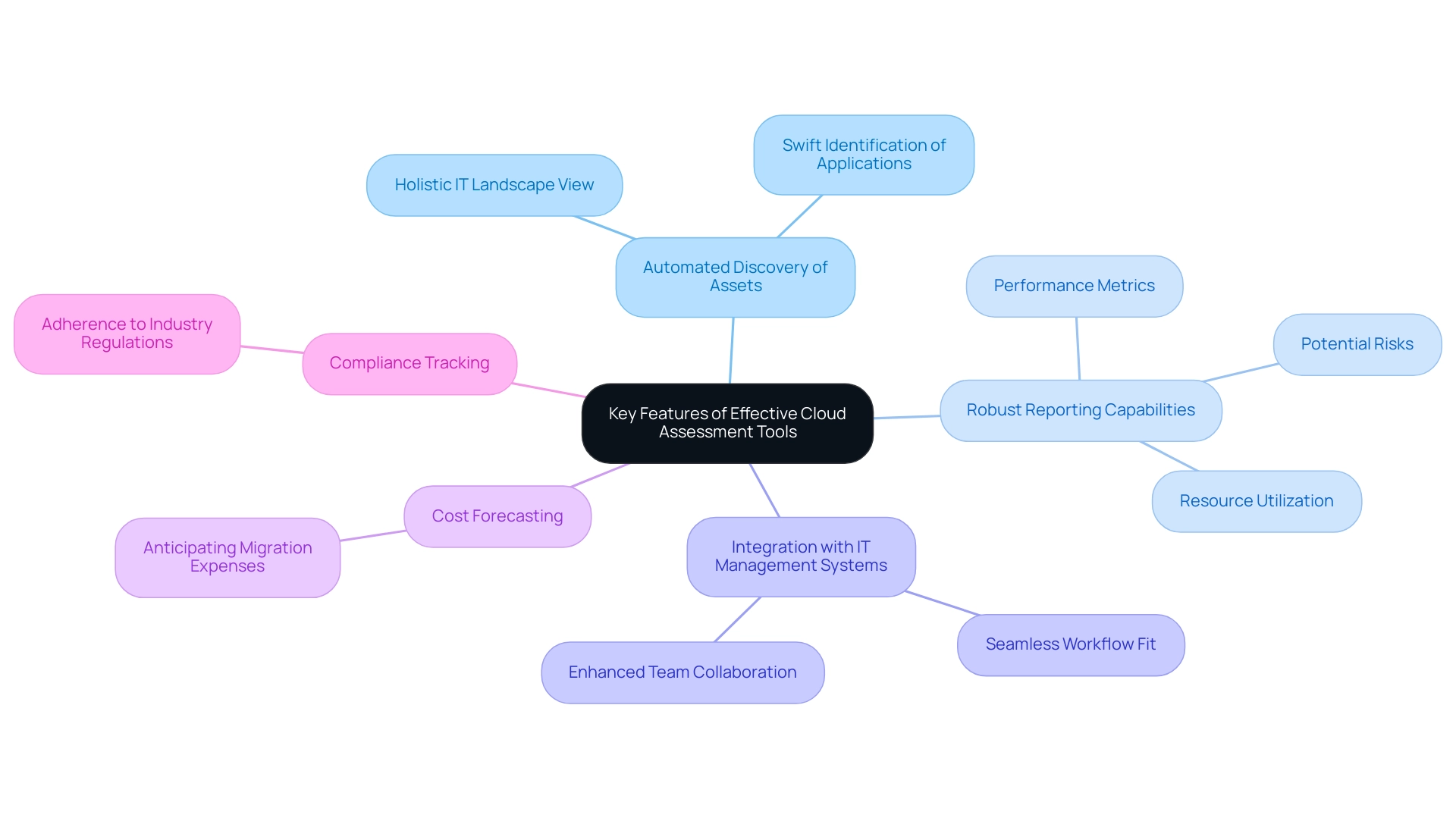
Challenges in Utilizing Cloud Assessment Tools
Despite the considerable benefits provided by cloud assessment tools, organizations frequently face numerous obstacles in their use. A prevalent issue is the complexity involved in accurately assessing legacy systems, which frequently lack compatibility with contemporary online environments. This challenge is compounded by data privacy concerns, particularly regarding the management of sensitive information during assessments.
Based on recent reports, over 50% of sensitive data assets are accessed by five to ten applications, while only 4% of companies indicate that all their sensitive data in online storage is adequately secured, highlighting the widespread challenges entities face in protecting sensitive information within digital environments. Furthermore, 41% of security professionals indicated that their entity's approach for staying updated with current risk management techniques for online services relies informally on self-training, highlighting the shortcomings in existing practices. Moreover, opposition from stakeholders reluctant to completely adopt digital technologies can hinder the successful implementation of these resources.
As mentioned by CloudFlare, in the first three months of this year, their automated systems thwarted over 4.5 million DDoS attacks, a 50% rise compared to the same period last year, highlighting the security challenges entities encounter. To address these challenges, entities should prioritize:
- Clear communication about the advantages of migration to a remote environment
- Actively engage key stakeholders in the evaluation process
- Utilize a cloud assessment tool to ensure their selected resources are customized to meet the specific needs of their IT infrastructure
By proactively tackling these challenges, companies can significantly improve the effectiveness of their digital evaluation efforts, ultimately resulting in a more secure and optimized online environment.
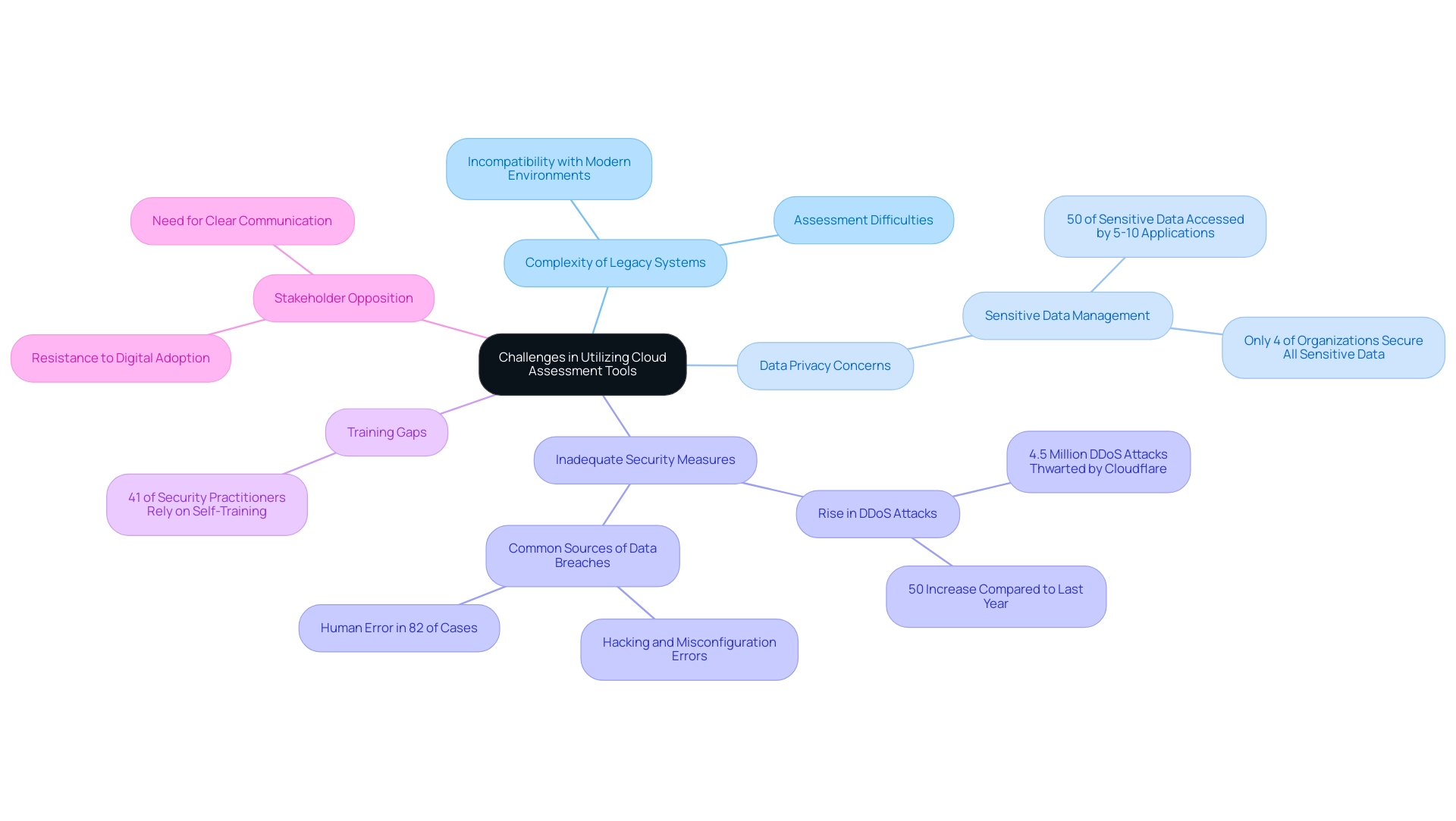
Best Practices for Implementing Cloud Assessment Tools
Successful execution of cloud assessment tools relies on several key best practices. Firstly, organizations must establish clear objectives for their evaluations, ensuring these are directly aligned with overarching business goals. This alignment not only enhances focus but also ensures relevance throughout the evaluation process.
Secondly, integrating cross-functional teams—including representatives from IT, finance, and operations—is vital. Their involvement fosters a broader understanding of organizational needs and cultivates buy-in for the initiatives. A recent survey indicated that involving cross-functional teams significantly enhances the effectiveness of evaluations, as it allows for a more comprehensive analysis of requirements and risks.
According to Veeam, half of surveyed enterprises emphasize the important function of online solutions in data protection strategies; therefore, providing teams with the appropriate resources is vital. Furthermore, with the U.S. and Western Europe representing 82% of the world's computing market, the significance of effective evaluations becomes even more pronounced in this global landscape. Thirdly, entities should prioritize user-friendly online evaluation tools like a cloud assessment tool and offer extensive training for personnel to guarantee maximum effectiveness.
Lastly, it is imperative to engage in continuous monitoring and evaluation of the assessment outcomes. This practice enables entities to adjust their strategies in reaction to changing business goals and new vulnerabilities in the online environment. A significant case study on security and compliance assessment demonstrates this point, illustrating how entities can review existing security measures, identify compliance needs, and evaluate potential risks in the digital environment.
By adhering to these best practices, organizations can significantly amplify the effectiveness of their cloud migration efforts while leveraging technology as a catalyst for business growth.
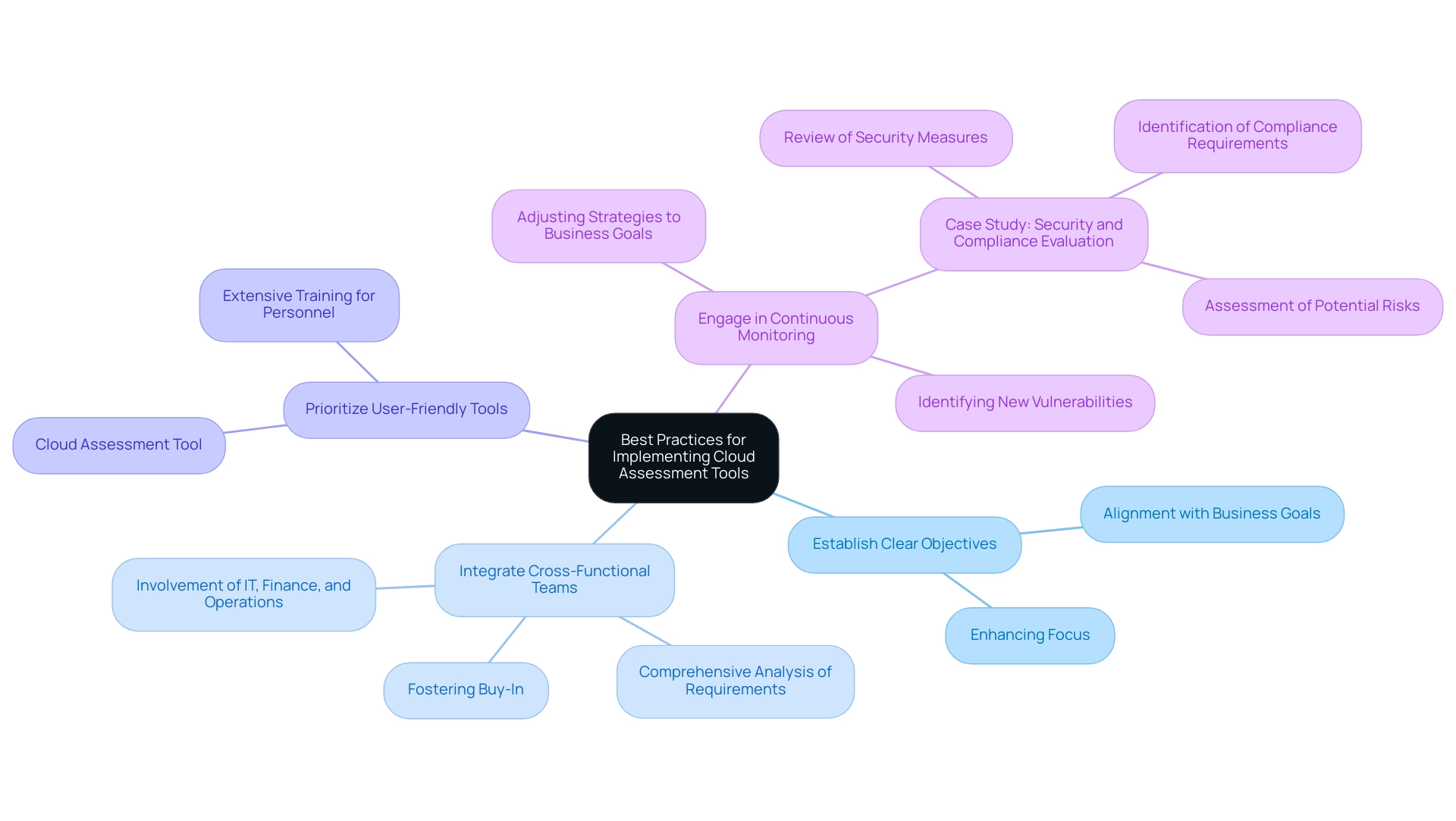
Conclusion
Successful cloud migration relies heavily on the effective utilization of cloud assessment tools, which provide essential insights into an organization’s readiness for transition. By analyzing existing IT infrastructures, application dependencies, and operational processes, these tools help identify risks and opportunities, enabling organizations to prioritize migration initiatives and allocate resources efficiently.
As the advantages of cloud technology become undeniable, robust cloud assessment tools play a crucial role in enhancing migration success rates while managing costs and ensuring compliance with regulatory standards. Features such as automated asset discovery and cost forecasting allow organizations to navigate the complexities of cloud environments effectively.
However, challenges remain, particularly concerning legacy systems and data privacy. To address these issues, organizations must prioritize transparent communication and actively involve key stakeholders throughout the assessment process. Implementing best practices, such as aligning assessments with business objectives and fostering cross-functional collaboration, will further improve the effectiveness of cloud migration efforts.
In conclusion, leveraging cloud assessment tools is vital for organizations aiming to modernize their IT infrastructure securely and efficiently. As the cloud landscape evolves, embracing these tools will be essential for navigating migration complexities, ensuring competitiveness, and enhancing operational resilience. The path to a successful cloud transition is attainable for those who effectively utilize these critical assessment tools.




